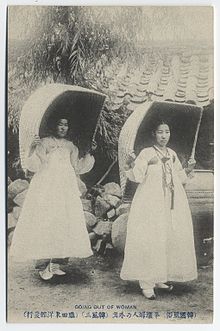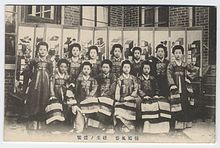Women's rights in North Korea
This article needs additional citations for verification. (November 2016) |

Women's rights in North Korea have varied throughout history. In recent history, major events of the 20th century, such as the Division of Korea and later the 1990s North Korean famine have played an important role in shaping sex relations.
Historical context
[edit]

Before 1945, in North Korea, women had very few rights. They were expected to give birth to male heirs and rear them to assure the continuation of the family line. Women had few opportunities to participate in the social, economic, or political life of society. In traditional Korean society, academic education was not considered important for women, and only a few received formal education. In the 19th century, it was Christian missionaries who established girls' schools, thus allowing young Korean females to obtain a modern education.[1] There were a few exceptions to these limitations. For example, female shamans were called on to cure illnesses by driving away evil spirits, to pray for rain during droughts, or to perform divination and fortune-telling.[1]
The social status and roles of women were radically changed after 1945. On July 30, 1946, authorities north of the thirty-eighth parallel passed a Sex Equality Law. The 1972 constitution asserted that "women hold equal social status and rights with men." The 1990 constitution stipulates that the state creates various conditions for the advancement of women in society. In principle, North Korean law supports sexual equality.[1]
Many challenges remained however. Although the new regime brought women more equal participation in the labor force outside the home and more access to education, women continued to be considered inferior to men. An example is the strong son preference, and the burden put on women to do most housework, and the different sex roles confirmed by the practice of separating boys and girls at both the elementary and higher middle-school levels. Some aspects of school curricula for boys and girls also are different, with greater emphasis on physical education for boys and on home economics for girls. However, in the four-year university system, women majoring in medicine, biology, and foreign languages and literature seem especially numerous.[1]
North Korea remains a highly patriarchal society, and the women's role in the family sphere and in the public sphere has changed several times from the end of World War II to this day. After the war, women were enrolled in the socialist economy in large numbers, and played a major role in the rebuilding of the country. But as the economy improved in later decades, women were less needed in the workforce, and a move towards more traditional roles emerged.[2]
State employees were given rations and most families could survive on that. But during the North Korean famine of the 1990s, these rations, known as the Public Distribution System, dried up and families had to look elsewhere for financial support. Men, even though they are not receiving payment, are still required to attend their government jobs. The cash-strapped government relies heavily on the free labor they get from men and it is unlikely to discontinue this practice anytime soon.[3]
For men to be free from work, they actually must pay their employer between 20 and 30 times their monthly salary, allowing them to take on other, more profitable jobs, such as repair work. This payment is required even if one is unable to afford food to eat, otherwise they are punished with jail time. The current involvement of women in the labor market is uncertain, because of the unregulated grey economy informal market economic system which has proliferated since the famine. According to Human Rights Watch, women traders in the informal sector are vulnerable to sexual violence and exploitation, and "implementation of rules and regulations over market operations are arbitrary and government officials can demand bribes and sexually harass and coerce women with impunity."[3]
Abuse against women
[edit]Even within the lowest rungs of the songbun system, the ascribed caste system of North Korea, women face unique hostilities. It is common for those living in poverty to turn to prostitution and drug use, and even those who manage to escape the country through China risk being sexually abused or trafficked.[4][better source needed]
Prostitution in North Korea
[edit]The great famine of the 1990s changed the North Korean society deeply that the world is still trying to understand the width and the depth of that change. During and after the famine, millions of North Koreans grasped at any survival strategy necessary to feed themselves. Those who did not change, and whom the state did not feed, died. For thousands of North Korean women, prostitution was the survival strategy of last way to feed themselves, and often, their children.[5]
In Kim Il Sung's North Korea, the sex trade was invisible to the outside world. That began to change when Chinese traffickers forced thousands of female famine refugees into the sex trade. By the end of the great famine, prostitution had become stealthily ubiquitous inside North Korea. It also became more organized and more predatory, with state officials playing a growing role in its patronage and protection.[5]
In Hamhung in 2008, a number of high-ranking party officials were accused of patronizing a tea house that also sold sex, and for protecting it against police interference. In Hyesan in 2009, the manager of a state-run inn frequently patronized by central party officials was arrested for pimping women and girls, some in their mid-teens. North Korea's 2009 currency "reform" drove more women into the sex trade. By 2010, prostitution in Chongjin had been organized by “couple managers” who matched customers, often soldiers, with sex workers, often female university students, and sometimes women who had become dependent on drugs. In 2014, the manager of a North Korean factory in China was accused of pimping out female factory workers.[5]
The reports do not suggest that the state has consciously chosen to tolerate or profit from the sex trade as a matter of policy. The security forces periodically crack down on the sex trade, but inevitably, when corrupt authorities attempt to police a profitable trade, the authorities begin to see that trade as just another way to supplement their pay. More fundamentally, in a society where officials are the law, where enforcement is arbitrary, and where the state profits from trade at least indirectly, it can be hard to tell the difference between corruption and state policy. Today, the Daily NK reports that prostitution is increasingly run by well-connected businessmen and protected by the officials they're connected with.[5]
A North Korean defector informed Ha Tae-kyung, a lawmaker of the Saenuri Party and publisher specializing in North Korea, that were approximately 500 prostitutes in their city, which has a population of 400,000.[6] “If [we] depend on the simple arithmetic calculation and put North Korean population as 20 million, we can assume that there should be about 25,000 prostitutes in North Korea,” Ha told Sieff.[6]
See also
[edit]References
[edit]- ^ a b c d "North Korea - The Role of Women". countrystudies.us. Retrieved 2016-11-15.
- ^ Je Son Lee (14 February 2015). "Ask a North Korean: are women treated equally in your society?". the Guardian.
- ^ a b "North Korea: Kim Il-Sung's Birthday No Celebration for Women". 13 April 2017.
- ^ "North Korea's War on Women". Weekly Standard. 2015-04-27. Archived from the original on January 14, 2016. Retrieved 2016-11-15.
- ^ a b c d "In North Korea, prostitution used to be a survival strategy. Now, it's just another racket". freekorea.us. 3 August 2015. Retrieved 2016-11-17.
- ^ a b "Does North Korea have sex trade and drug problem?". The Korea Observer. 2015-02-04. Archived from the original on 2016-11-23. Retrieved 2016-11-22.
External links
[edit]- Sexual Violence Against Women by Officials report by Human Rights Watch, 2018
